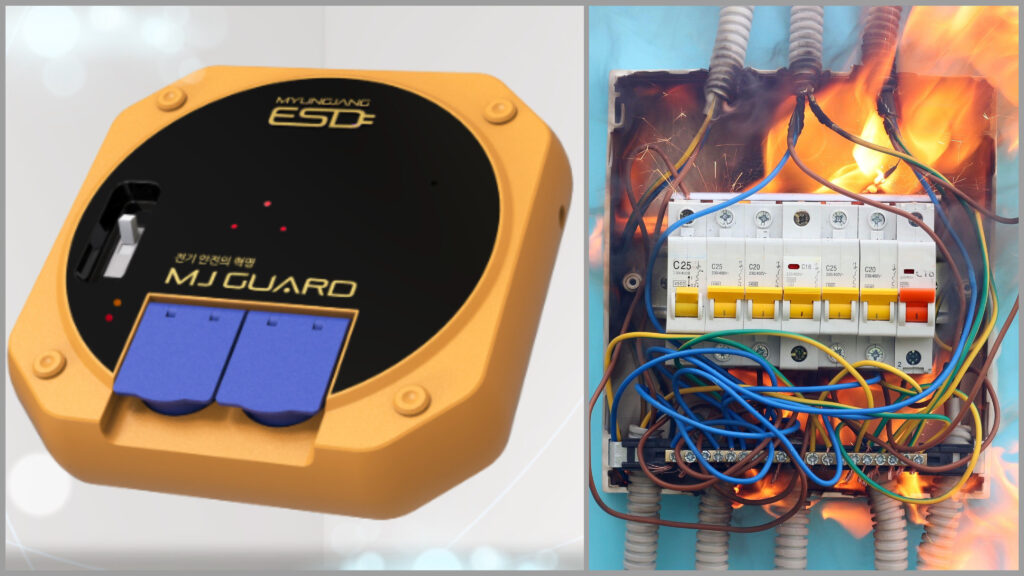
(Source from Reuters/Alamy)There are a resistive leakage current generated when a wire coating is peeled off or water is introduced, and a capacitive leakage current in which a high-frequency current generated in a high-frequency device such as an SMPS reaches a metal product case. As products such as inverter air conditioners and LED lighting fixtures increase, the leakage breaker may be blocked due to such capacitive leakage current.
In a simple circuit diagram, the former is represented as having a resistor inserted between the ground and the power line, and the latter as a capacitor connected between the ground and the power line.
Since capacitive leakage has a difference of 90 degrees between voltage and phase angle, the effective power transmitted due to leakage is zero. Therefore, it may be considered that there is no fire risk due to the capacitive leakage itself. However, if a person additionally contacts a place where capacitive leakage occurs, there may be a risk of electric shock. In the case of IGR short circuit breaker, which was banned from distribution in early 2022, distribution was banned for this reason. In this case, it can be considered that a capacitive leakage source (capacitor) and a human body (resistor) are connected in series between the power line and the ground.
According to the revised KEC regulations in 2021, if the leakage current (resistance leakage current) is less than 1 mA, the insulation resistance can be considered good. There is a rule that the malfunction of the breaker due to the capacitive leakage current can be solved to some extent by introducing the IGR blocking. However, even if an IGR breaker is introduced, it will trip if the resistive leakage current flows above the trip current or the total leakage current exceeds 100mA. In this case, even if an IGR breaker is introduced, the circuit is separated to reduce or change the leakage current of the individual breaker itself to a smaller leakage current.
But what would you do if you had a device that held 0mA? With this technology, M.J.ENC would not only leak electricity, but also stay at 0mA even if the device was immersed or tested in water. This can be extremely safe for electric shock or short circuit.
If a short circuit occurs, problems such as poor condition or poor supply of the device that receives current may occur, and in severe cases, a lot of caution is required because it may shock the user.
It usually occurs when using old electronic devices. When electricity is connected or electric wires are used, it is a dangerous phenomenon that sparks fly from the area, causing a user to electrically shock or explode the device.
The reason why a short circuit is really dangerous is because of secondary damage. There are also injuries caused by a user’s electric shock or an explosion of the device, but it is because a fire can occur due to connected plug-ins.
Fortunately, most of the families we usually live in have short circuit breakers, so the risk of electric shock due to short circuit is greatly reduced unless the short circuit breaker fails, but the situation itself is very dangerous and can occur easily, so care is always needed.
Even if a leakage breaker is installed, the device must be grounded because it may not work properly if the device is in poor ground condition. Considering the electric device grounded to the steel enclosure, if a leakage occurs in the enclosure due to poor insulation, a leakage current is generated through the ground wire, causing the leakage breaker to trip. The leakage does not occur due to sufficient insulation resistance between the iron housing and the ground, but when the voltage is abandoned, a person becomes a path of the leakage current and the leakage current flows and the circuit breaker trips. In this way, the presence or absence of ground makes a difference in whether the breaker operates in advance before the human body is electrocuted or after contact with the human body.
In an ideal state, electric devices having an insulating structure have a structure in which a short circuit is unlikely to occur. For example, SMPS, which is designed with an insulated topology, has the primary and secondary sides separated by a lottery transformer (magnetic coupling). The feedback circuit is also separated by a photo-coupler If this design is reflected, if there are no problems with the insulation interval in the substrate design, consideration of induced voltage, actual insulation performance of insulating components, etc., equipment connected to the secondary side would not feel electricity when touched. In the case of these devices, the secondary voltage is floating.If there is something wrong and the potential is high enough for the human body to feel, the electricity will be felt when the human body comes into contact with the reference ground. In the case of arbitrarily adding a ground wire, this ground is connected to the real ground to make the reference potential 0 V so that no electricity is felt.
It is already a proven product and has developed a receptacle that covers up to 300mA.Of course, larger capacities can be covered, but the company (M.J.ENC) recommends 300mA above per outlet of the device. And it is a product that has two outlet codes on the device so that multiple outlets can be used.

▲MYUNGJANGESD CO.,LTD.
▲ CEO : Min-Ju Kim
▲www.myungjangesd.co.kr
▲ mjesd0603@naver.com
▲ +82-32-575-1601
EJ SONG
ASIA JOURNAL

